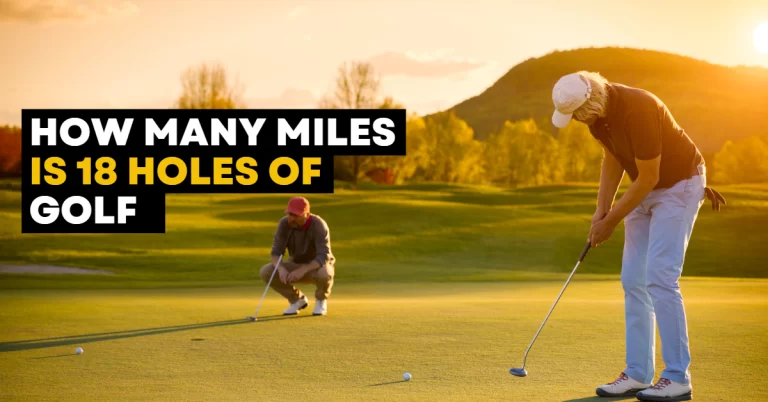What is a Tight Lie in Golf: Complete Guide
Golf is a game of challenges and opportunities. Every shot you face on the course requires you to assess the situation and choose the best strategy and technique to execute it. One of the factors that can affect your shot selection and outcome is the type of lie you have. What is a tight lie in golf? A lie is the position of the ball on the ground, and it can vary depending on the condition of the course, the weather, and the luck of the bounce.
What Is Meant by A Tight Lie In golf?
A tight lie is one of the most challenging lies you can encounter on the golf course. A tight lie is when your ball rests on a spot with very little or no grass underneath it. This could mean your ball is on thin, sparse, shaved turf, bare dirt, or hardpan. A tight lie also means that the ground under your ball is firm or compact, making it harder to get under it and take a divot.
A tight lie can pose several challenges for golfers of all skill levels. It can limit your shot options, increase your margin of error, and affect your confidence and swing tempo. It can also cause you to hit foul shots such as tops, thins, fats, or blades, ruining your score and enjoyment.
However, a tight lie does not have to be a nightmare. With some knowledge, practice, and adjustments, you can learn how to play tight lies in golf and turn them into opportunities to showcase your skills and creativity. This article will explain what causes tight lies, how to identify and play them, and how to avoid them. We will also answer some frequently asked questions about tight lies in golf.
What Causes Tight Lies in Golf?
Tight lies are usually caused by one or more of these factors:
Course conditions:
Some courses are designed or maintained to have tight lies on specific areas, such as fairways, fringes, or tee boxes. This could be done to create more challenge, variety, or aesthetics for the golfers. Tight lies are common on links courses or courses with dry or sandy soil.
Weather conditions:
Dry, hot, cold, or windy weather can affect the growth and health of the grass on the course. This can result in tight lies on some spots where the grass is burned out, frozen, or blown away by the wind.
Seasonal changes:
The grass on the course can change depending on the season. The grass can go dormant in winter and lose its color and thickness. In spring and summer, the grass can grow faster and longer. In fall, the grass can be covered by leaves or debris. These changes can create tight lies on different parts of the course throughout the year.
Luck of the bounce
Sometimes, tight lies are just a matter of luck or unluck. Your ball might land on a spot where there is a patch of thin or bare turf, or it might roll off a slope or a mound and end up on a hardpan surface. These situations are unpredictable and unavoidable, but they are part of the game.
How to Identify a Tight Lie in Golf?
Identifying a tight lie in golf can be challenging and obvious. Sometimes, you might think you have a good lie until you get closer to your ball and see hardly any grass under it. You might also notice your ball sitting on firm or compact ground once you hit it.
To identify a tight lie in golf, you need to pay attention to these clues:
The appearance of the turf:
Look at the grass’s color, length, density, and texture around your ball. The grass is dry, dead, or frozen if it is brown, yellow, gray, or white. If the grass is very short, If the grass is very short, shaved, or mowed, it means that it is sparse or thin. It is authoritarian or rigid if the grass is coarse, wiry, or rough. There is no grass at all if you see any dirt, sand, or gravel patches. Any of these signs indicate that you have a tight lie.
The feel of the ground:
Use your feet, hands, or club to test the firmness or hardness of the ground under your ball. It is hard or firm if the ground feels solid, compact, or unyielding. It is soft or moist if the ground feels soft, loose, or springy. A rigid or firm ground means that you have a tight lie.
The position of the ball:
Look at how your ball is sitting on the turf. If your ball rests on the grass, there is very little or no grass under it. If your ball is nestled or buried in the grass, plenty of grass is under it. A ball sitting on top of the grass means that you have a tight lie.
How to Play a Tight Lie in Golf?
Playing a tight lie in golf requires your club selection, setup, and swing adjustments. Here are some general tips on how to play a tight lie in golf:
Choose the right club:
Depending on the distance and trajectory you need for your shot, you can choose between a low-lofted club (such as an iron or a hybrid) or a high-lofted club (such as a wedge). A low-lofted club can help you hit a low and running shot that skims over the hard surface and rolls toward the target. A high-lofted club can help you hit a high and soft shot that flies over obstacles and stops near the target.
However, it would be best if you also considered your club’s bounce and sole width. A low-bounce and narrow-sole club can help you avoid hitting behind the ball and bouncing off the ground. A high-bounce and wide-sole club can cause you to hit too high on the ball and blade it across the green.
Set up correctly:
To play a tight lie in golf, you must set up slightly differently than usual. Moving the ball back in your stance, closer to your back foot, would be best. This will help you hit down on the ball and make clean contact with it. It would help if you lean your weight slightly towards your front foot. This will help you create a steeper angle of attack and prevent hitting behind the ball. You must also grip down on your club slightly to shorten your swing and improve your control.
Swing smoothly:
It would help if you swung smoothly and confidently to play a tight lie in golf. You must avoid swinging too fast, hard, or steeply, as these can cause you to mishit the ball or dig into the ground. You must also avoid lifting or scooping the ball, as these can cause you to top or thin the ball.
You must swing with a smooth tempo and rhythm, keeping your head still and your eyes on the ball. It would help if you made a shallow and sweeping swing, brushing the turf lightly without taking a divot. You need to follow through fully and finish with a balanced pose.
How to Avoid Tight Lies in Golf?
The best way to avoid tight lies in golf is to avoid hitting your ball into areas where they are likely to occur. It means aiming for areas with more grass, such as fairways, greens, or roughs. It also means avoiding areas with less grass, such as bunkers, hazards, or bare spots.
However, sometimes tight lies are unavoidable due to course conditions, weather conditions, seasonal changes, or luck of the bounce. In these cases, you need to accept the challenge and play them as best as you can.
Conclusion
A tight lie in golf is when your ball rests on a spot with very little or no grass underneath it, and the ground under your ball is firm or compact. A tight lie can make your shot more complex and challenging, as it limits your shot options, increases your margin of error, and affects your confidence and swing tempo. However, with some knowledge, practice, and adjustments, you can learn how to play tight lies in golf and turn them into opportunities to showcase your skills and creativity. We hope that this article has helped you understand what is a tight lie in golf and how to play it.







3 Comments